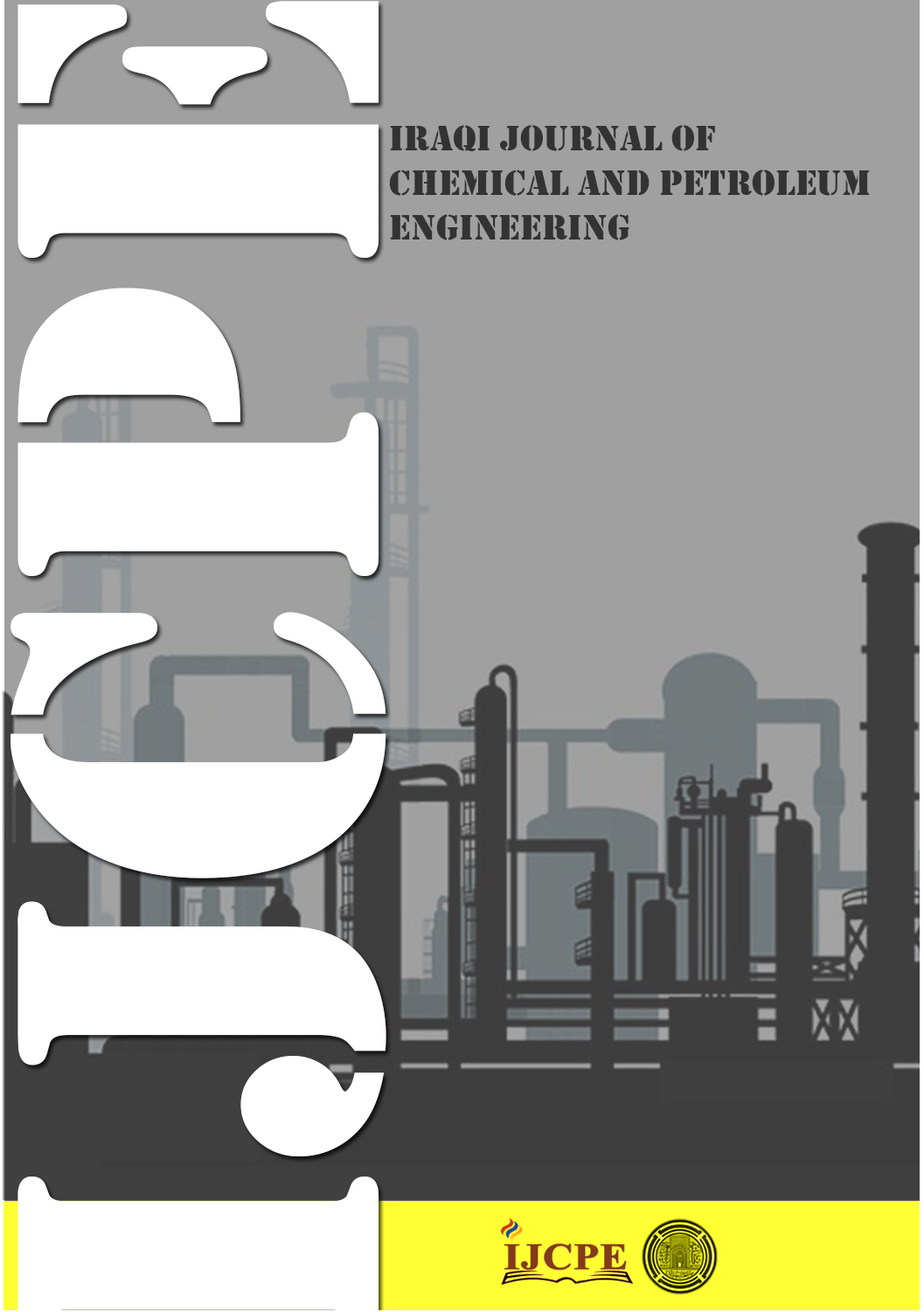Modification of Y-zeolite mesoporosity by ultrasonic-assisted technique as active catalysts for catalytic cracking of VGO
DOI:
https://doi.org/10.31699/IJCPE.2025.3.16Keywords:
Mesopore volume; Y zeolite; dealumination; Ultrasonic-assisted desilication; Modified Zeolite; VGO; catalytic crackingAbstract
In this study, Pristine Y zeolite (CBV 400) of Si/Al )2.5( was treated to produce modified mesoporous zeolites. The process involved the aid of post-synthesis sequential dealumination in its conventional mode and ultrasonic-assisted desilication techniques. Both ethylene-diaminetetraacetic acid (EDTA) and oxalic acid (OX) were tested as chelating reagents in the dealumination step for 1, 3, and 6 h. The dealuminated samples of zeolite were treated sophisticatedly with sodium hydroxide NaOH in a water bath sonication at a frequency of 20 Hz and 65 ºC for different times of 5 and 15 min. Dealumination of the original zeolite by OX acid for 3h and desilication of the acid-treated sample with NaOH solution for 15 min has improved the mesoporosity by around 120% higher than the parent sample of Vmeso=0.08 m3/g. The modified sample has a mesopore volume (Vmeso) of 0.2 m3/g and an external surface area (Sexternal) of 89 m2/g. The resulting mesoporous zeolite was examined for stability measurements via thermal treatment at 550 ºC for 3h, which reveals high stability. Parent and modified zeolite were tested as heterogeneous catalysts for the catalytic cracking reaction with VGO and 1g catalyst load with different temperatures (from 400 to 420 °C) and a reaction time of 480 minutes. The reaction was carried out using a batch reaction system, and a higher yield of gasoline (about 44.44 vol%) was obtained using the modified zeolite (UDSY15-OX3) at 420 °C reaction temperature, as opposed to the direct use of the non-modified catalyst, which gives out only 18.4 vol% gasoline yield. Thus, commercializing the OX-NaOH pathway with the assistance of ultrasonic energy can decrease the treatment duration and energy consumption, producing a thermally stable mesoporous material to catalyze the cracking reactions of heavy oils.
Received on 04/05/2025
Received in Revised Form on 07/07/2025
Accepted on 07/07/2025
Published on 30/09/2025
References
[1] H. Kondoh, K. Tanaka, Y. Nakasaka, T. Tago, and T. Masuda, “Catalytic cracking of heavy oil over TiO2-ZrO2 catalysts under superheated steam conditions,” Fuel, vol. 167, no. November, pp. 288–294, 2016, https://doi.org/10.1016/j.fuel.2015.11.075
[2] U. Khalil et al., “Robust surface-modified Beta zeolite for selective production of lighter fuels by steam-assisted catalytic cracking from heavy oil,” Fuel, vol. 168, pp. 61–67, 2016, https://doi.org/10.1016/j.fuel.2015.11.085
[3] P. Danial-Fortain, T. Gauthier, I. Merdrignac, and H. Budzinski, “Reactivity study of Athabasca vacuum residue in hydroconversion conditions,” Catalysis Today, vol. 150, no. 3–4, pp. 255–263, 2010, https://doi.org/10.1016/j.cattod.2009.10.002
[4] S. Ebrahimi, J. S. Moghaddas, and M. K. R. Aghjeh, “Study on thermal cracking behavior of petroleum residue,” Fuel, vol. 87, no. 8–9, pp. 1623–1627, 2008, https://doi.org/10.1016/j.fuel.2007.08.015
[5] A. A. Al-Shammari et al., “Catalytic cracking of heavy naphtha-range hydrocarbons over different zeolites structures,”Fuel Processing Technology., vol. 122, pp. 12–22, 2014, https://doi.org/10.1016/j.fuproc.2014.01.021
[6] J. L. Agudelo, E. J. M. Hensen, S. A. Giraldo, and L. J. Hoyos, “Influence of steam-calcination and acid leaching treatment on the VGO hydrocracking performance of faujasite zeolite,” Fuel Process. Technology., vol. 133, pp. 89–96, 2015, https://doi.org/10.1016/j.fuproc.2015.01.011
[7] M. O. Kazakov et al., “Hydrocracking of vacuum gas oil over NiMo/Y-Al2O3: Effect of mesoporosity introduced by zeolite Y recrystallization,” Catalysis Today, vol. 305, no. August 2017, pp. 117–125, 2018, https://doi.org/10.1016/j.cattod.2017.08.048
[8] R. Saab, K. Polychronopoulou, L. Zheng, S. Kumar, and A. Schiffer, “Synthesis and performance evaluation of hydrocracking catalysts: A review,”Journal of Industrial and Engineering Chemistry, vol. 89, pp. 83–103, 2020, https://doi.org/10.1016/j.jiec.2020.06.022
[9] B. Paweewan, P. J. Barrie, and L. F. Gladden, “Coking and deactivation during n-hexane cracking in ultrastable zeolite Y,” Applied Catalysis A: General., vol. 185, no. 2, pp. 259–268, 1999, https://doi.org/10.1016/S0926-860X(99)00143-X
[10] A. A. Alyassiry and R. T. A. Alrubaye, “Desulfurization of model gasoline using metal organic frame-work,” AIP Conferace. Proceedings., vol. 2213, no. March, 2020, https://doi.org/10.1063/5.0000242
[11] C. Rallan, R. Al-Rubaye, and A. Garforth, “Generation of catalytic films of alumina and zeolites on FeCralloy rods,” Chemical Engineering Transactions., vol. 43, no. May, pp. 907–912, 2015, https://doi.org/10.3303/CET1543152
[12] S. Mardiana, N. J. Azhari, T. Ilmi, and G. T. M. Kadja, “Hierarchical zeolite for biomass conversion to biofuel: A review,” Fuel, vol. 309, p. 122119, 2022, https://doi.org/10.1016/j.fuel.2021.122119
[13] K. Li, J. Valla, and J. Garcia-Martinez, “Realizing the commercial potential of hierarchical zeolites: New opportunities in catalytic cracking,” ChemCatChem Reviews, vol. 6, no. 1, pp. 46–66, 2014, https://doi.org/10.1002/cctc.201300345
[14] Kunhao Li and Julia Valla and Javier Garcia-Martinez, “Realizing the Commercial Potential of Hierarchical Zeolites: New Opportunities in Catalytic Cracking”Chem Cat Chem Reviews no. 207890, 2014. https://doi.org/10.1002/cctc.201300345
[15] M. Moliner, C. Martínez, and A. Corma, “Multipore zeolites: Synthesis and catalytic applications,” journal of the German Chemical Society., vol. 54, no. 12, pp. 3560–3579, 2015, https://doi.org/10.1002/anie.201406344
[16] E. F. T. Lee and L. V. C. Rees, “Dealumination of sodium Y zeolite with hydrochloric acid,” Journal of the Chemical Society, Faraday Transactions 1: Physical Chemistry in Condensed Phases vol. 83, no. 5, pp. 1531–1537, 1987, https://doi.org/10.1039/F19878301531
[17] Y. S. Kareem, H. Q. Hussein, and W. S. Abdul-majeed, “The effect of hydrothermal conditions on surface properties of synthesized nano SBA-15 using sodium silicate,” Iraqi Journal of Chemical and Petroleum Engineering, vol. 25, no. 3, pp. 153–160, 2024. https://doi.org/10.31699/IJCPE.2024.3.16
[18] S. Van Donk, A. H. Janssen, J. H. Bitter, and K. P. De Jong, “Generation, characterization, and impact of mesopores in zeolite catalysts,” Catalysis Reviews Science and Engineering., vol. 45, no. 2, pp. 297–319, 2003, https://doi.org/10.1081/CR-120023908
[19] R. Zhang et al., “Using ultrasound to improve the sequential post-synthesis modification method for making mesoporous Y zeolites,” Frontiers of Chemical Science and Engineering, vol. 14, no. 2, pp. 275–287, 2020, https://doi.org/10.1007/s11705-019-1905-1
[20] S. Abdulridha et al., “A Comparative Study on Mesoporous Y Zeolites Prepared by Hard-Templating and Post-Synthetic Treatment Methods,” Applied Catalysis A, General., vol. 612, no. December 2020, 2021, https://doi.org/10.1016/j.apcata.2020.117986
[21] Y. Han, K. Larmier, M. Rivallan, and G. D. Pirngruber, “Generation of mesoporosity in H–Y zeolites by basic or acid/basic treatments: Towards a guideline of optimal Si/Al ratio and basic reagent,” Microporous and Mesoporous Materials., vol. 365, 2024, https://doi.org/10.1016/j.micromeso.2023.112906
[22] E. T. C. Vogt and B. M. Weckhuysen, “Fluid catalytic cracking: recent developments on the grand old lady of zeolite catalysis,” Chemical Society Reviews., vol. 44, no. 20, pp. 7342–7370, 2015, https://doi.org/10.1039/c5cs00376h
[23] S. Abdulridha et al., “An efficient microwave-assisted chelation (MWAC) post-synthetic modification method to produce hierarchical Y zeolites,” Microporous and Mesoporous Materials., vol. 311, no. July 2020, p. 110715, 2021, https://doi.org/10.1016/j.micromeso.2020.110715
[24] S. Abdulridha, Y. Jiao, S. Xu, R. Zhang, and A. A. Garforth, “Mesoporous Zeolitic Materials ( MZMs ) Derived From Zeolite Y Using a Microwave Method for Catalysis,” Frontiers in Chemistry vol. 8, no. June, pp. 1–13, 2020, https://doi.org/10.3389/fchem.2020.00482
[25] A. N. C. Van Laak, S. L. Sagala, J. Zečević, H. Friedrich, P. E. De Jongh, and K. P. De Jong, “Mesoporous mordenites obtained by sequential acid and alkaline treatments - Catalysts for cumene production with enhanced accessibility,” Journal of Catalysis, vol. 276, no. 1, pp. 170–180, 2010, https://doi.org/10.1016/j.jcat.2010.09.011
[26] Danny Verboekend, Sharon Mitchell, Maria Milina, Johan C. Groen, and Javier Perez-Ramírez, “Full Compositional Flexibility in the Preparation of Mesoporous MFI Zeolites by Desilication,” The Journal of Physical Chemistry C 115(29) pp. 46–57, 2014, https://doi.org/10.1021/jp201671s
[27] F. Shakir, H. Q. Hussein, and Z. T. Abdulwahhab, “Synthesis and Characterization of Nano Silica from Iraqi Sand by Chemical Precipitation with Different Acid Types,” AIP Conferace. Proceedings., vol. 2660, no. November, 2022, https://doi.org/10.1063/5.0107741
[28] M.M. Yahya, R. T. A. ALrubaye, and A.A.T. Al-Ani, “Effect of Tetramethylammonium Hydroxide (TMA-OH) Cation Concentration on Omega Zeolite Crystal Size,” Conference Portal, 3rd International Conference on Petroleum, 2024.
[29] D. Verboekend, S. Mitchell, and J. Pérez-Ramírez, “Hierarchical zeolites overcome all obstacles: Next stop industrial implementation,” Chimia (Aarau)., vol. 67, no. 5, pp. 327–332, 2013, https://doi.org/10.2533/chimia.2013.327
[30] D. Verboekend, N. Nuttens, R. Locus, J. Van Aelst, P. Verolme, J.C. Groen, B.F. Sels, Synthesis, characterization, and catalytic evaluation of hierarchical faujasite zeolites: milestones, challenges, and future directions. Chemical Society Reviews. 45, 2016, 3331. https://doi.org/10.1039/C5CS00520E
[31] S. M. Al-jubouri, “The static aging effect on the seedless synthesis of different ranges Faujasite-type zeolite Y at various factors,” Iraqi Journal of Chemical and Petroleum Engineering vol. 20, no. 4, pp. 7–13, 2019. https://doi.org/10.31699/IJCPE.2019.4.2
[32] D. Verboekend, G. Vilé, J. Pérez-Ramírez, “Hierarchical Y and USY zeolites designed by post-synthetic strategies,”advanced functional matereals vol. 22, no. 5, 2012, https://doi.org/10.1002/adfm.201102411
[33] M.S. Jabbar and R. T. A. ALrubaye, “No TitleMetal Organic Frameworks as Gas Storage for Liquefied Petroleum Gas Vehicle in Iraq,” AIP Conferance. Proceedings2660 020012, 2022, https://doi.org/10.1063/5.0108325
[34] N. H. Ibrahim, S. M. Al-jubouri, and A. Alfutimie, “Preparation and Characterization of a Hierarchically Porous Zeolite-Carbon Composite from Economical Materials and Green Method,” Iraqi Journal of Chemical and Petroleum Engineering vol. 24, no. 3, pp. 27–32, 2023. https://doi.org/10.31699/IJCPE.2023.3.3
[35] R. Prasad and Y. S. Shivay, “Oxalic acid / oxalates in plants : from self-defence to phytoremediation,” Current Science Association no. lApril, 2017, https://doi.org/10.18520/cs/v112/i08/1665-1667
[36] C. Paper, Z. Ayad, and H. Q. Hussein, “Synthesis and characterization of high silica HY zeolite by basicity reduction,” AIP Conference . Proceedings no. March, 2020, https://doi.org/10.1063/5.0000278
[37] R.T.A. ALrubaye and A.A. Garforth, “Study the Effect of Various Parameters on the Synthesis of ZSM-5 Zeolite”, Journal of Engineering, 34, 30 2018, https://doi.org/10.31026/j.eng.2018.11.03
[38] B. Pospiech and M. Warzecha, “Application of oxalic acid as an efficient leaching agent of aluminum from industrial waste,” Physicochemical Problems of Mineral Processing vol. 56, no. 2, pp. 264–270, 2020.
Downloads
Published
Issue
Section
License
Copyright (c) 2025 The Author(s). Published by College of Engineering, University of Baghdad.

This work is licensed under a Creative Commons Attribution 4.0 International License.













